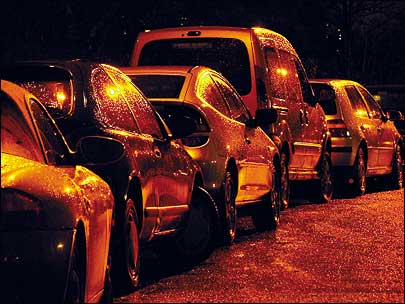In one episode of the popular sitcom Seinfeld, George tells Elaine that paying for space in a parking garage “is like going to a prostitute. Why should I pay when, if I apply myself, maybe I could get it for free?” Many New Yorkers agree. On average, they spend 14 minutes driving around looking for a parking space. That waste of time and fuel might soon be a thing of the past. Researchers at MIT’s SENSEable City Lab are working on a project that involves using ad hoc sensor networks that indicate whether a parking space is open. Using a cell phone, a driver could access the system to locate the nearest empty space.
At the heart of the system are SmartStickers-small, self-contained electronic devices that would be embedded in the street. They use a microcontroller with Wi-Fi capabilities to communicate with each other and Ethernet or Wi-Fi to link to the Internet. When deployed, SmartStickers would run on batteries that are recharged by photovoltaic cells. LEDs or an electronic ink display on the device would indicate the status of the parking spot, such as available, restricted or paid.

To determine whether a space is occupied, SmartStickers could use either an infrared beam and detector or an ultrasonic transmitter and sensor similar to the ones used in cars for detecting the distance to obstacles. The device would communicate with an RFID tag embedded in the pavement to identify the specific spot, and then the information would be passed from one SmartSticker to another until it eventually reached a Wi-Fi router connected to the Internet. Then the data would be uploaded to a server and stored in a database.
A driver would send a request for a parking spot using the cell phone’s text-messaging capability. The server application would determine the driver’s location using the GPS transmitter in the phone and look up the two closest unoccupied parking spaces in the database. The server application would then send directions back to the driver either by a map/animation using the phone’s Multimedia Messaging Service or by voice directions.
Several companies have introduced technology to try to solve the problem of finding a parking space in urban areas. What makes the SENSEable Lab’s approach different is that each SmartSticker will not have to be within range of a fixed access point to be part of the network but just within the broadcast range of another sticker. And only one sticker out of about a dozen would have to serve as a gateway to the Internet. This makes the system flexible and less expensive to deploy.
Carlo Ratti, director of the lab, and David Lee, the student leading the effort, say the technology exists today to make the application work. Their prototype SmartStickers cost more than $100 each, but would come down in cost if mass-produced. They expect to begin testing the system this summer. If there are any telecommunications companies interested in providing the service, we know the perfect pitchman: Jason Alexander, the actor who played George.

